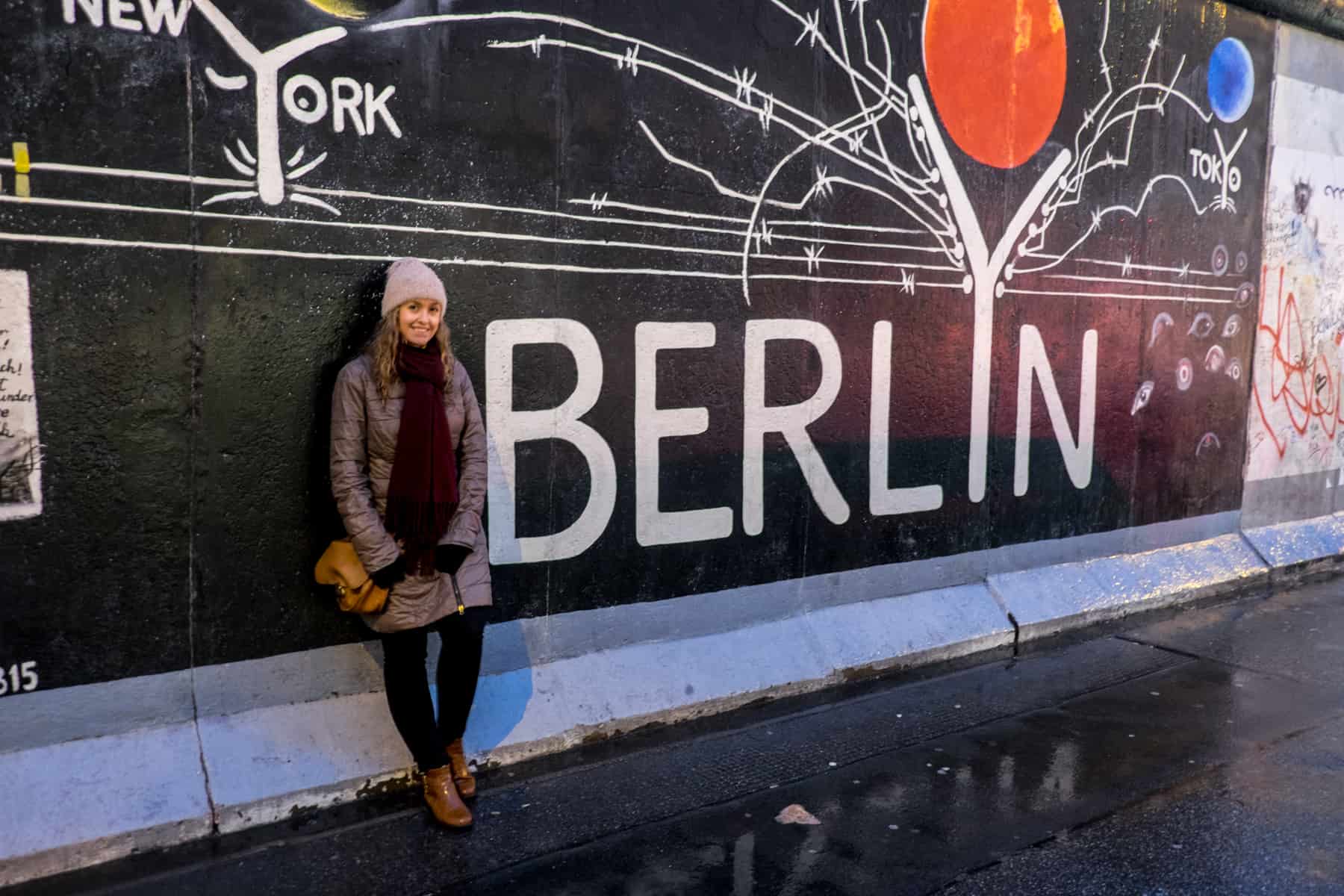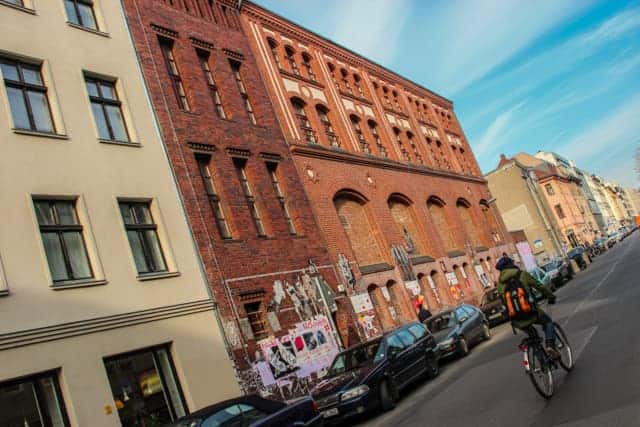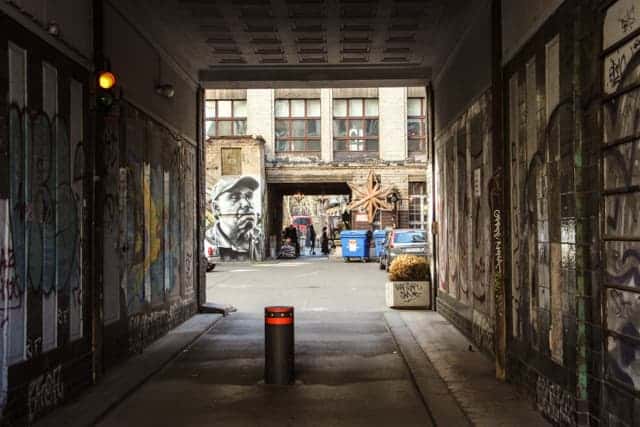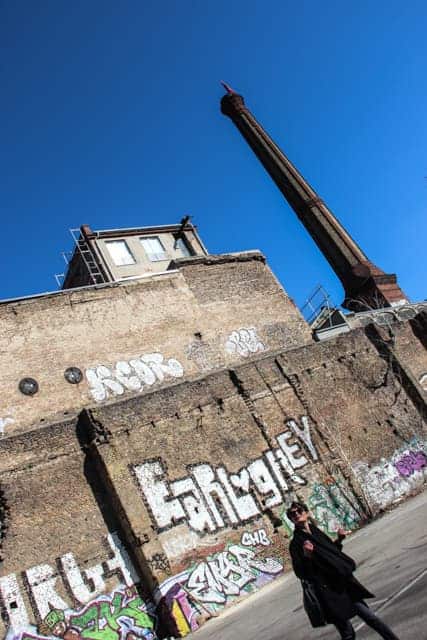Disclaimer: This post contains affiliate links to handpicked partners, including tours, gear and booking sites. If you click through or buy something via one of them, I may receive a small commission. This is at no extra cost to you and allows this site to keep running.
What is Berlin like, and what is Berlin known for? Once divided, now united in freedom and creativity, how do distinct markers of former East and West Berlin merge 30 years on from the fall of the wall in 1989?
Berlin is not a city you can visit just once – fascinating and difficult to define, a visitor will always be chasing after the answer to what Berlin is, trying to untangle its complex history, unravel its dark secrets and pinpoint its persona. Like me, you may be forever at the mercy of its ever-changing personality and enjoy the conundrum of its difference.
Evolving and progressing from a past of east and west division into a present of multi-layered uniqueness, Berlin’s continuous reinvention of its dark past is exactly what defines it. It thrives on change.
Berlin stands out from the rest of Germany, where once it was enclosed within it, let loose to be its own entity after being so encroached upon. What was once walled up and carved in half is now a united playground of freedom, expression and creativity since the wall came down.
Today Berlin city stands divided only by levels of urban cool. People no longer stand on towers to peer into the static east; instead, they want to be in the east. The west still shines in richer glory, maintaining itself as the commercial centre of the city; the west becoming half of the city trying to catch up.

Understanding Berlin Since the Fall of the Wall
Contents
What is Berlin Like? East and West After the Fall of the Wall.
East is East, and West is West. Shall the Twain Ever Meet?
Berlin has changed dramatically since the fall of the Wall and German reunification. Historic buildings have been restored, new districts have emerged, and the stagnant and grey concrete buildings left by the Soviets are swathed in the colour of street art, graffiti and ‘urban stickering’.
Yet, as time moves on, the old lines of East and West seem to be becoming blurred.
READ MORE: Berlin Wall Museums and Exhibitions to Understand the Cold War Era
What Berlin Neighbourhoods to Explore – The Strongholds
Charlottenburg in the west remains the affluent area of Berlin, marked by its beautiful and spacious residential buildings, open parks and the royal palace, and Freidrichstein and Mitte in the east maintain their urban edge as the much-favoured neighbourhoods. You quickly learn that much.
During both my visits to Berlin, I chose to live in apartments in the former East areas, so it’s clear I’m biased. The West may have prospered, but people moved to the East after the fall of the wall to snap up cheap property and turn factories into clubs and warehouses into theatres. As a result of gentrification, the East gained in character what it never had in money, and that became an attraction.
I look at Friedrichshain as beige but burgeoning. The old ‘Soviet workers’ residences and prestigious architecture stretch along Karl-Marx-Alee and Frankfurter Allee, and standard concrete apartment blocks fill the rest of the space. The young and hip who moved in reinvented the space, opening creative businesses, cafes, and bars. It’s a place where ugly and retro is cool, where buildings have been restored or refined by fresh paint and graffiti.
Mitte is the centre of Berlin, and it houses many of the must-see sites representing its past and future, including the modern political centre of Potsdamer Platz, the restored Reichstag and Museum Island, Alexanderplatz, the Brandenberg Gate, the Memorial to the Murdered Jews of Europe, and Checkpoint Charlie. Mitte was once surrounded by the Berlin Wall to its north, south, and west.
Mitte, to live in, was just as dynamic as its Friedrichshain neighbour. Although more cleaned-up, it’s still buzzing with new enterprises, boutique stores and edgy hangouts.
The Blurred Lines of Modern Berlin
Prenzlauer Berg in the east is so upmarket that you might have to second-guess which side of the city you are in. It’s affluent in a trendy way, pretty and aspiring, quiet but full of character, and more bohemian and chic than the typical grittiness that defines the East. Yet its history lingers.
The hillside water towers, part of the grounds used by the Nazis to torture their victims, are now luxury apartments; outdoor table tennis tables, once fitted with the surveillance chips of the Stasi secret police, remain for recreation.
The Rykestrasse Synagogue, which survived the “Kristallnacht” (Night of Broken Glass) burning because of top-ranking Nazis living in the adjacent residential buildings, is surrounded by alfresco diners and café culture vultures. An old squat building remains on the main thoroughfare, adorned with an artistic “Capitalism kills and destroys” slogan.
Kreuzberg, in the former west, is now the latest ultra-cool space. It screams ‘former’ east – the ugly buildings at Kottbusser Tor being some of the ones you will first come across as you exit the metro station – but was, in fact, the poorest part of the west.
Sealed from neighbouring Friedrichshain by the Berlin Wall, Kreuzberg was itself divided into east (postcode SO36 and the most ‘blocked-in area’ because of the wall) and west (postcode SO61).
Before the wall came down, Kreuzberg brewed with an anti-capitalist and anti-establishment sentiment. Berlin was the only place in Germany where National Service wasn’t compulsory (because of its ‘occupied’ status), so east Kreuzberg became the area that attracted ‘service dodgers’ who fled here to take advantage of squatting opportunities.
While squatting is no longer a huge problem here, the movement did save some of Berlin’s old architecture, much of which is covered in street art and graffiti depicting ‘36’. The area does retain its anti-capitalist feeling, with no Starbucks, H&M or Burger King to be found, although McDonald’s staked its claim. In Berlin, politics is cool.
Berlin – The Modern Additions
In the east, hasty property developers are quick to move in to stamp a modern mark on a treasured area of ultra-urban.
The graffiti that is seen on the building alongside the river Spree stating: “F**k Off Media Spree” highlights Berlin’s response to the planned development over its reinvented past and its feelings towards Media Spree, whose job it is to pull down all the old buildings that house the bars and clubs and turn them into media and communications buildings. The drinking hole institution of the Yaam Bar is already scheduled to move a few doors down from its current location.
In the west, development now includes the cool additions of refurbished post-war buildings such as the 25hours Hotel Bikini, an old high-rise turned swanky rooftop bar that overlooks the zoo and Tiergarten Park. Elsewhere, scaffolding and piping line the skies and paths as the West thinks of its next commercially viable move.
It’s anyone’s guess what area will be the next big thing or reveal a new addition to its landscape; reinvention seems fast-moving here.
Change defines Berlin, and I think time will slowly blend the halves as each side slowly mirrors the best parts of the other.
But one thing remains certain. Berlin is a city in constant rejuvenation, yet reluctant to forget the past that first defined it.
How to Better Understand Berlin
Where to Stay in Berlin
Over the years, I found various apartments in Berlin on platforms like Airbnb and Booking.com, choosing ones in Mitte and neighbouring areas because of their central location and ease of transport links. It’s the perfect opportunity to live like a local and be right in the heart of a trendy neighbourhood.
There are numerous hostels in Berlin, possibly too many to choose from. I stayed at the modern Pfefferbett Hostel because it offered something different, especially on the design front. It’s located on the historic grounds of the industrial monument and brewery “Pfefferberg” in Berlin’s trendy Prenzlauer Berg district, and it has a cool vibe. There is also a U-Bahn (metro) outside for ultimate convenience. For those wanting to be based very centrally in the Mitte area, I recommend Wombats, Circus and Generator, which I have spent a lot of time in (although have never stayed overnight). The Circus Hostel is another prime Berlin accommodation with a great cellar bar and David Hasselhoff shrine.
Getting Around Berlin
Berlin is a huge city, and while particular neighbourhoods can be combined and explored on foot, you really need to get to grips with the city’s transport network. You’ll mainly be using the Berlin metro (Ubahn) and intercity rail system (Sbhan) to be able to explore it in its entirety, and it takes a bit of getting used to. I’ve been to Berlin many times, and I still have to pack a little patience and master the best route.
This article on how to get around Berlin goes deeper into city zones and gives tips for using the trams and buses.
Top tip: Always validate your ticket before boarding.
Extra Things to Do in Berlin
Walking Tours in Berlin
The best way to explore Berlin is with locals and on walking tours. One of my favourites is the ‘Real Berlin Experience’ walk with Alternative Berlin, which took me through most of the neighbourhoods listed in this article. This is a great opportunity to learn about Berlin away from the tourist trail since it doesn’t take you to any of the main tourist sites, which you can easily seek out in your own time.
See Alternative Berlin
Berlin is the centre of everything alternative—from urban revival to hidden places, cafe culture, and nightlife. There is always something changing or being made in Berlin. No two visits are ever the same, so you might want to branch out after seeing the main highlights.
This great list of ‘alternative’ things to do in Berlin includes urban exploration sites, creative cafes, and restaurants.
One of my top choices is to take one of the Berlin Underground tours, where you can learn about secret city war bunkers, escape tunnels, abandoned metro stations and more.
Or why not see the city from a different angle and go base flying off Berlin’s tallest hotel?
For an overview of the best photo spots in Berlin and how to capture its myriad of personas, check out this guide by local photographers here.
Thinking of Visiting Berlin? Save This for Later
Berlin was the starting point for my ‘Fall of the Wall’ trip to the towns and cities of former East Germany, which I conducted in conjunction with the German National Tourist Office to examine modern Germany and how it’s changed since reunification. All opinions remain my own.



















NZ Muse says
Though we only had a few days there I fully back what you say about it being a city of enigma and intrigue. Berlin was a really fascinati city and I would happily go back!
Jason says
This article definitely made me think about how much can change in such a relatively short amount of time. Thanks for the great read!
Julia Browne says
Hi Becki, enjoyed your post. I am planning a trip for students to Berlin and your post helps me get some idea of what Berlin is about. Also interesting because I live in a city in Canada that used to called Berlin, before the war.
Cheers.
Becki says
I first visited Berlin as part of a student group – I’m glad you found the post of use in your planning.
Glamourous Traveller says
Cool post and wonderful pictures. It really does capture that dichotomy between both sides
Sammy Dorn says
Really great post Becki. I haven’t been to Berlin yet, but am planning a weekend there soon. I have friends that are coming over from Australia in September to go to Berlin. They are really excited, so I am going to send them this article to check out!
Sammi says
I, too, stayed in Mitte when I first went to Berlin. I am returning again this summer to stay with a friend which I am really looking forward to, though I’m not sure which part of the city she lives in. Either way it will be nice to get a different perspective.
Becki says
I always try and stay in a different neighbourhood each time I go back. It makes it more interesting, to have a new area to explore.
Jen says
Well written and great photos Becki. Berlin is such an interesting and diverse city. I loved my time there and after I left felt I had seen enough but over time I have started to feel drawn back there as though I have never been. I’m sure there is so much more for me to explore.
Becki says
Berlin certainly has a draw that can’t be easy explained!
J in Beijiing says
Great post Becki. I have only been to Berlin once (2 years ago) but I would love to go back. It is a fascinating place. We managed to visit quite a few different neighbourhoods while we there and enjoyed the mixture of modern and cool along with the historical side.
Becki says
You will be surprised how much has changed, even in two years!
EurotripTips says
Such a great piece, Becki. I love how you described the neighbourhoods so distinctly — I had no idea Prenzlauer held such history. I was only there for a few hours and I wish I’d known about all these stories, it would have made me appreciate the area with a whole new perspective.
Becki says
I think every corner of Berlin has history… and secrets. Next time I visit for a while, I hope I uncover some more!
Tammy says
Beautiful post Becki. It is so hard to describe Berlin as it is so contradictory, but you really did it justice. I went on a street art tour with Alternative Berlin and loved it too. My favourite parts are Prenzlauer Berg, which is where I lived in my friend’s apartment, and Kreuzberg, because it is so rebellious. Just the place to plan our next revolution from. 🙂
Becki says
There’s no better praise then from a German on Germany – thank you!! I am jealous that you got to live in Prenzlauer Berg, although when I am there in a couple of weeks I am going to try out a funky hostel there. I can’t wait! And on Kreuzberg, I agree. I think our reunion would be very well placed there 🙂 Love for Berlin, always!